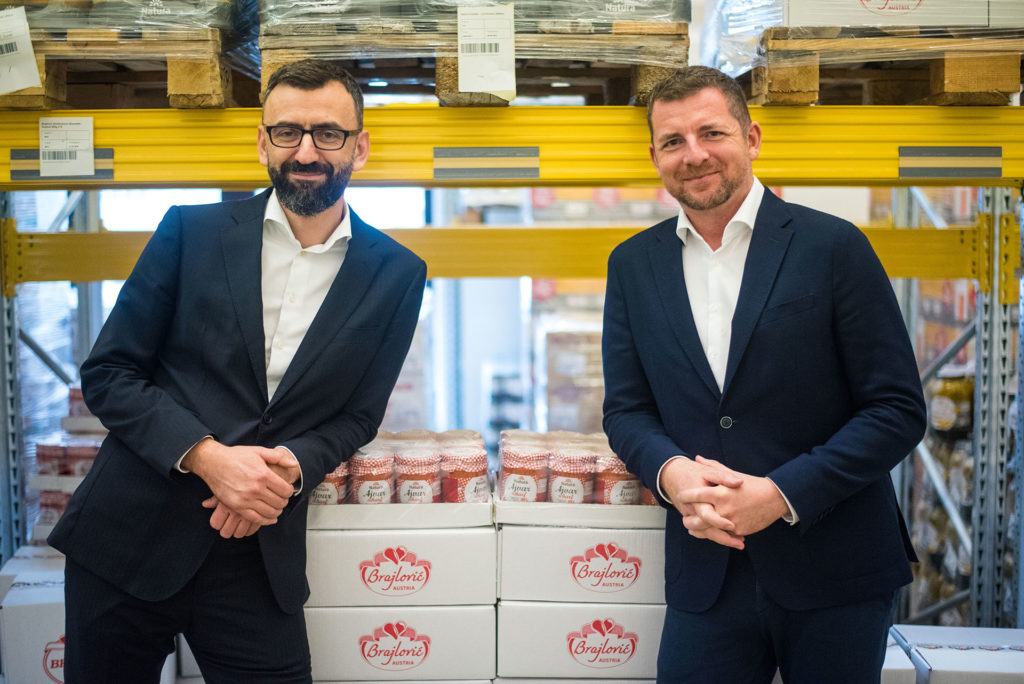In the meantime, it is hard to imagine domestic supermarkets without ethnoshelves. Today, every supermarket chain operating in this country can no longer do without well-known food products from former Yugoslavia or Turkey: Some brands such as Vegeta, Argeta or Brajlovic have already arrived in the Austrian mainstream for a long time.
One of the main reasons for this, however, is no longer just the migrant communities, which by nature also have an emotional affinity for these brands. “There are also more and more Austrians who know certain brands from their vacations in the Adriatic region like in Croatia or Montenegro. When they see them on the shelves of their supermarket, they grab them more and more often, also because they often associate them with a nice memory from their vacation”, explains Amin Reda, Sales Director of the Adriatic Group. This is the leading company in the food sector when it comes to the distribution of products from the Western Balkans on the EU market.



Ethnofood: EU-weit eine Erfolgsgeschichte
The Vienna-based group, which has been operating in Austria since 2003, is now represented in 16 EU countries with more than 500 products. With a total annual turnover of 80 million, the Group is a pan-European company with ten subsidiaries. “Across the EU, we are present in about 10,000 stores. In Austria alone, there are a few hundred and the demand continues to grow. In Germany, we are increasingly working with REWE. A massive expansion of ethnic shelves is currently happening there”, Adriatic Group CEO Anel Ćerimagić says.
Whether in Munich, Dublin or Amsterdam: “The procedure is basically always similar. We test the products in small ethnic markets and, depending on their success, we then put them on the shelves of large supermarkets. Not a single product has ever been delisted again, each one is a success story in itself,” Mr. Reda, who is responsible for the Adriatic Group’s sales strategy together with Mr. Ćerimagić, tells us. After founding the group in 2003, the two Viennese discovered a gap in the market when they became the first major importers to start bringing food products from former Yugoslavia to the Austrian market. “Even then, it quickly became clear to us: ethnofood is not a short-term trend, but rather a real economy answer to Austria’s demographic development”, Mr. Reda says.
„Das Prozedere ist grundsätzlich immer ähnlich. Wir testen die Produkte in kleinen Ethnomärkten und, abhängig vom Erfolg, bringen wir sie dann in die Regale großer Supermärkte. Kein einziges Produkt wurde je wieder ausgelistet, jedes ist eine Erfolgsgeschichte für sich“,
Amin Reda, CSO Adriatic Group
Immigration and emigration flows still play a role today: for example, one can already observe the new, third wave of immigration of people from the region of Ex-Yugoslavia. “Everyone talks about the immigrants from the nineties, but also in the last few years a lot of people come from the Balkan region. The advantage is that we didn’t even have to specifically attract this group, for example, unlike second- and third-generation immigrants. They were already customers who are already used to these brands and products from home. What’s more, most of them have purchasing power right from the start”, Mr. Reda and Mr. Ćerimagić explain. Likewise, demand has increased in recent years in Ireland, a country to which many Croatians have emigrated in recent years.
Die unterschätzte Kaufkraft
Neben der Demographie, die vor allem für die Markteinführung von Ethnoprodukten ein wichtiges Fundament ist, ist die oft noch immer unterschätze Kaufkraft das größte Potenzial des Ethno-Food-Marktes. „Es gab 2010 eine Studie, nach der die Kaufkraft von Menschen mit Migrationshintergrund in Österreich 20 bis 25 Milliarden Euro war. Mittlerweile sind fast 10 Jahre vergangen und diese Zahl dürfte nun um einiges höher ausfallen. Weiters zeigt uns die Erfahrung, dass unsere Kunden keine preissensible Zielgruppe sind: Sie zahlen bewusst für die eine Marke, die sie haben möchten und deren Geschmack bzw. Qualität sie kennen. Auch an kleinen Standorten, wo wir vor einigen Jahren jährlich nur wenig Umsatz erwirtschaftet haben, hat sich die Situation in den letzten Jahren sukzessive geändert.
Wir sehen das an der gesteigerten Nachfrage und den eigenen Verkäufen: Der echte Boom von Ethno-Food steht uns erst bevor“,
konstatiert Anel Cerimagic, CEO
Wir sehen das an der gesteigerten Nachfrage und den eigenen Verkäufen: Der echte Boom von Ethno-Food steht uns erst bevor“, so CEO Cerimagic. Obwohl heutzutage vor allem Free-from-Produkte einen großen medialen Hype erleben, sei das Potenzial von Ethno-Food – alleine aufgrund demographischer Zahlen – weitaus größer, betont man in der Adriatic Group. „Laktosefreie Produkte sind für eine überschaubare Anzahl der Menschen in Österreich ein Thema. Ethno-Lebensmittel – wenn man an die ex-jugoslawische Community z.B. denkt – jedoch für fast 800.000 Menschen“, so Reda.
„Mut, der sich auszahlt“: Penny als Marktführer
Even though no supermarket chain in Austria can now do without ethnic shelves, “Penny, for example, has recognized the full extent of the potential and has greatly expanded its ethnic assortment in several product groups. Furthermore, since this year there have also been regular flyer campaigns there that are dedicated to this topic. The corresponding sales figures speak for themselves.” As Mr. Ćerimagić and Mr. Reda report, Penny gave them the chance to prove themselves with their products in several niches – from refrigerated assortments to confectionery. The trend of ethnic products to the mainstream can be seen, for example, in the brands from Italy or China. They were once also introduced as ethnic products and now represent standard assortments. “In addition to the enormous financial benefits, ethnoshelves are also a politically important signal of inclusivity: diversity on the shelves can be used to consciously steer against the division of society”, Mr. Reda emphasizes.
Der Top-Seller: Cevapcici made in Österreich
Apart from distributing well-known brands from countries of Ex-Yugoslavia, Adriatic Group also relies on in-house products such as ajvar (homemade style) or Brajlovic’s cevapcici, which both became a top seller. They boast an original Bosnian recipe combined with Austrian meat: at the in-house Brajlovic company, the raw materials and added value come 100% from Austria.
Ethno-Regale: Schweden und England als Vorreiter
Although there have never been as many ethno products present on the domestic market as there are today, the development of these brands and products in Austria is still in its infancy, especially compared to other European countries such as Sweden or England. As Anel Cerimagic and Amin Reda tell us, ethnic shelves in English or Swedish hypermarkets are now between 10 and 20 meters long. “In Austria, people are still relatively frugal with one to three meters in the supermarkets of the large chains, but we are sure that this will change in the medium term”, the two experts say.
